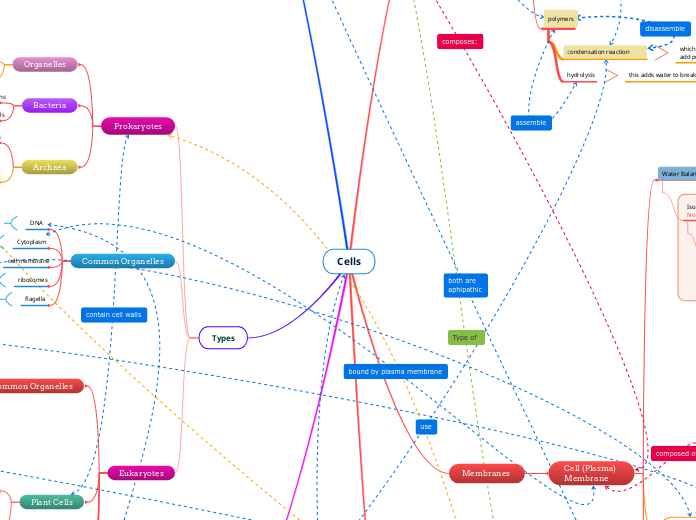
simple sugars
Glucose
linear/ ring
alpha/beta^
cellulose is an example of beta glucose
gylcogen/starch is an example of alpha glucose
Subtopic
structural
cellulose and chitin
are examples of
structural glucose
storage
glycogen, starch and dextron are
examples or storage glucose
Monosaccharides
Polysaccharides
glycosdic linkages
polymers
condensation reaction ^
hydrolysis
Cell (Plasma)
Membrane
Water Balance
Isotonic Solution
No net water movement
Hypertonic Solution
Cell loses water
Hypotonic Solution
Cell gains water
Proteins
Integral
Anchored to the
Membrane
Transport proteins
Passive Transport
Facilitated Diffusion
Channel Proteins
Provide channels that allow
specific molecules to cross
Carrier Proteins
Change in shape translocates
solute binding site across
membrane
Active Transport
Sodium Potassium pump
Transports Na+ and K+ Ions
Bulk Transport
Large molecules
cross membrane in bulk
Transmembranes
Secondary structure
that contains:
N-Terminus
C-terminus
Alpha Helixes
amino acids
amino grouo
main chain
carboxyl group
Peripheral
Inserted inside
the membrane
Enzymatic proteins
Storage
Defense
transportation
hormonal proteins
contractile/motor proteins
receptors
structural
Phospholipids
fatty acids
unsaturated
is solid at room temperature
no double covalent bonds
cis/trans isomers
(known for it's kink)
saturated
is liquid at room temperature
1 or more covalent bonds
Phospholipids
triglycerides
steroids
Prokaryotes
Organelles
Pili
Capsule
Bacteria
more versetile, more variations
contain peptidoglycan in cell walls
Archaea
cell wall is made of lipids
types
halophiles
thermophiles
methanogens
Common Organelles
DNA
Cytoplasm
cell membrane
ribosomes
flagella
Eukaryotes
Common Organelles
nucleus
mitochondria
rough endoplasmic reticulum
smooth endoplasmic reticulum^
lysosomes
golgi apparatus
peroxisomes
Plant Cells
organelles
choloroplasts
large vacuole
cell wall
processes
photosynthesis
Animal
organelles
centriole
processes
cellular respiration
Subtopic
Subtopic
DNA/RNA
complimentary base pairing
A=G and C=T
double helix shaped
nucleictides
has a phospate, 5 carbon sugar
and a nitrogenous base